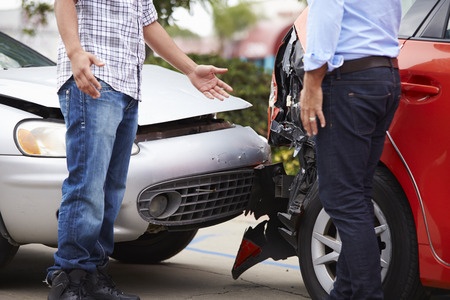How Long Will It Take To Stop Your Vehicle?
September 2, 2016 | Category: Automobile Accidents, Motorcycle Accidents, Personal Injury, Truck Accidents | Share
In our busy world there never seems to be enough time to do anything let alone arrive at a specific place at a specific time. Because of this when traveling on our interstate highways and I-75 in particular, drivers who leave enough room  between their vehicles and the vehicle in front of them are often confronted with the situation of another vehicle taking up that “cushion space.” This results in the potential for accidents and injuries.
between their vehicles and the vehicle in front of them are often confronted with the situation of another vehicle taking up that “cushion space.” This results in the potential for accidents and injuries.
WebTrafficSchool.com states it is just an equation: Reaction Distance + Braking Distance = Stopping Distance.
- The Reaction Distance is the distance the car travels in the three-quarters of a second that it takes for a driver to react to a problem and apply the brakes.
- The Braking Distance is the distance traveled from the time the brakes are first applied to the time the car comes to a complete stop.
- The Stopping Distance is the total distance it takes to stop the vehicle, from the moment the driver sees a problem to the time the car is stopped completely.
Using the above equation, WebTrafficSchool.com gives the following approximate distances for an average passenger car with good brakes in good conditions on dry concrete:
At 20 mph: Reaction Distance of 31 feet + Braking Distance of 36 feet = Stopping Distance of 67 feet. This means if you are traveling at only 20 mph, you have to allow 67 feet of stopping distance for your vehicle after recognizing a hazard.
At 40 mph: Your Reaction Distance is 83 feet and your Braking Distance is 152 feet, resulting in a Stopping Distance of 235 feet.
|
At 60 mph: Your Reaction Distance is 187 feet and your Braking Distance is 293 feet, resulting in a Stopping Distance of 480 feet. The Florida Drivers’ Handbook says that high speeds greatly increase stopping distances and the severity of crashes. The faster you drive, the greater the impact or striking power of your vehicle. • Double your speed from 20 to 40 mph, the braking distance and impact are 4 times greater. • Triple the speed from 20 to 60 mph, the braking distance and impact are 9 times greater. (Stopping distance is equal to a football field.) • Quadruple your speed from 20 to 80 mph; the braking distance and impact are 16 times greater. Should another vehicle suddenly come into your “cushion space” what should you do? The rule of thumb is that the safest distance between vehicles traveling in the same lane is 3 seconds in ideal driving conditions. This would mean the vehicle would have to change lanes or back off to maintain the safe traveling distance. In hazardous conditions or heavy traffic, SmartMotorist.com, recommends: 3 seconds - Ideal Conditions: daylight, clear weather, dry roads, and light traffic 6 seconds – Moderate Conditions: heavy traffic, darkness, light rain, light fog Allow even more time – Poor Conditions: heavy rain and thick fog How to determine the right distance? DriversEdGuru.com recommends that the first thing to do is to select a fixed object on the road ahead. This fixed object can be a sign, tree or overpass. When the vehicle ahead of you passes the object, slowly count “one one thousand, two one thousand, and three one thousand.” If you reach the object before completing the count, you are following too closely. Making sure there are three seconds in ideal conditions between you and the car ahead of you will give you the time and distance to respond to any problems. “Should you or a loved one suffer injury as the result of another vehicle’s cutting in front of you or tailgating your vehicle, be sure to contact our experience team of lawyers, at Spivey Law Firm, Personal Injury Attorneys, P.A. Tailgating is illegal in Florida and can be dangerous,” said Fort Myers Vehicle Accident Attorney, Randall Spivey.
Fort Myers Personal Injury Attorney,Randall L. Spivey is a Board Certified Civil Trial Attorney – the highest recognition for competence bestowed by the Florida Bar and a distinction earned by just 1 percent of Florida attorneys. He has handled over 2,000 personal injury and wrongful death cases throughout Florida. For a free and confidential consultation to discuss your legal rights, contact the Spivey Law Firm, Personal Injury Attorneys, P.A., in Lee County at 239.337.7483 or toll free at 1.888.477.4839, or by email to Randall@SpiveyLaw.com. Visit SpiveyLaw.com for more information. You can contact Spivey Law Firm, Personal Injury Attorneys, P.A. in Charlotte County at 941.764.7748 and in Collier County 239.793.7748.
|

